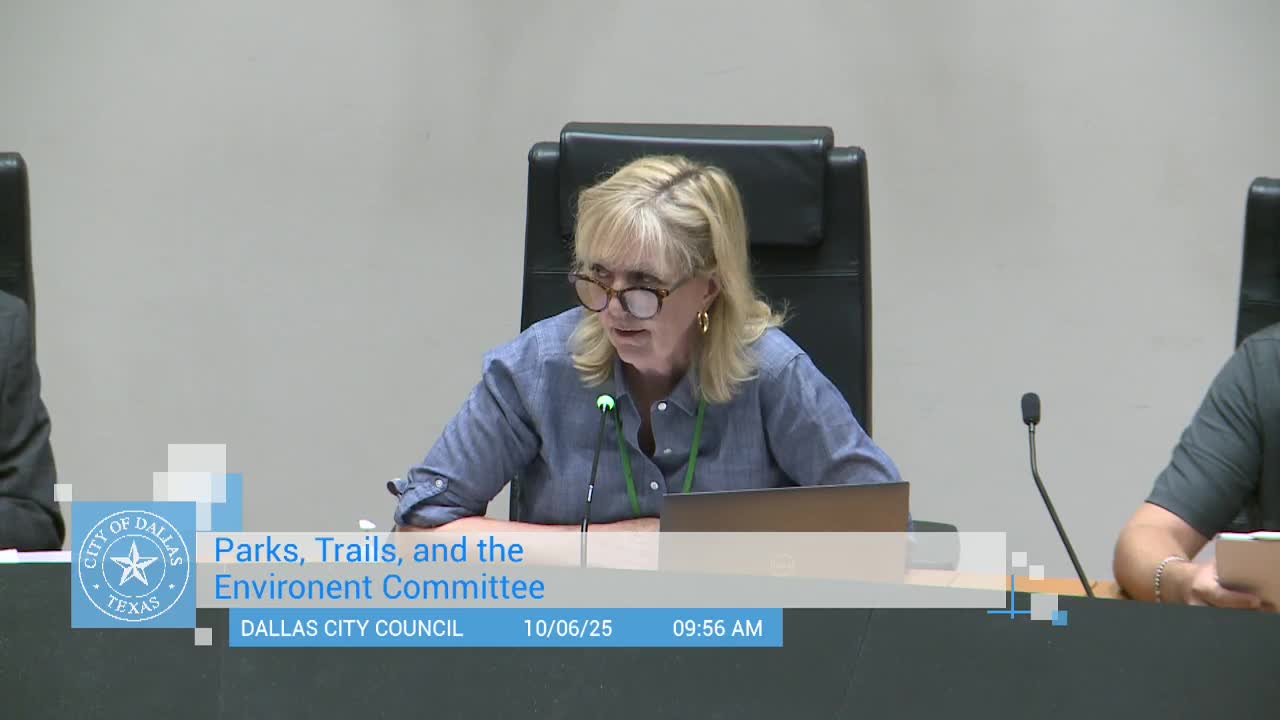Dallas to use $1 million HUD grant for environmental assessment at Hensley Field shoreline
October 06, 2025 | Dallas, Dallas County, Texas
This article was created by AI summarizing key points discussed. AI makes mistakes, so for full details and context, please refer to the video of the full meeting. Please report any errors so we can fix them. Report an error »

City environmental staff told the Parks, Trails, and the Environment Committee on Oct. 6, 2025, that $1,000,000 in HUD Community Project Funding will be used to fund environmental assessment and potential removal of contaminated soil at Hensley Field as part of planned shoreline and creek restoration tied to future redevelopment.
Committee members sought clarity on scope after the briefing memo used the title “shoreline modification,” which several members said could imply erosion repair or shoreline restoration. Laurie Troelsen, environmental risk manager in the Office of Environmental Quality and Sustainability (OEQS), said the grant-funded work is primarily characterization — additional soil and sediment sampling across the planned creek and shoreline area — and, if contamination is found, funds would help pay for removal before construction.
“This focus is really related to master planning and the redevelopment,” Troelsen said. “The Navy is fully responsible for doing their portion with PFAS, but this is about the redevelopment where we are proactively wanting to restore a creek channel…we want to put in some additional sampling points, understand the condition of the soil there, before any redevelopment starts.”
Interim Director Paul White and OEQS staff said the grant funds are intended to support the city’s assessment and any necessary remedial actions connected to city-led shoreline disturbance. Staff said the Navy remains responsible for PFAS response tied to its activities, and that this HUD funding is not a payment to address the Navy’s PFAS liability.
If sampling identifies impacted soil or sediment, staff said they will develop a sampling and analysis plan, hire an environmental consultant, and coordinate with state and federal stakeholders — including the Texas Commission on Environmental Quality (TCEQ), the U.S. Environmental Protection Agency (EPA) and Texas Parks and Wildlife — to determine cleanup steps prior to work by a future master developer.
Council Member Paul Ridley said the project title “shoreline modification” is misleading and suggested renaming it to reflect the assessment focus. Staff agreed that the grant supports assessment and potential remediation to enable redevelopment, not shoreline repair funded by this grant.
No formal action was taken during the briefing. Staff said they received the delayed HUD Community Project Funding award and would use the funds to characterize and, if needed, remove contaminated materials near the planned creek and shoreline prior to redevelopment, and that multiple stakeholders would be engaged in any remedial action planning.
Next steps described by staff include developing a sampling and analysis plan, retaining an environmental consultant, and coordinating with state and federal agencies to design any needed remedial actions before construction activities begin under a future master developer.
Committee members sought clarity on scope after the briefing memo used the title “shoreline modification,” which several members said could imply erosion repair or shoreline restoration. Laurie Troelsen, environmental risk manager in the Office of Environmental Quality and Sustainability (OEQS), said the grant-funded work is primarily characterization — additional soil and sediment sampling across the planned creek and shoreline area — and, if contamination is found, funds would help pay for removal before construction.
“This focus is really related to master planning and the redevelopment,” Troelsen said. “The Navy is fully responsible for doing their portion with PFAS, but this is about the redevelopment where we are proactively wanting to restore a creek channel…we want to put in some additional sampling points, understand the condition of the soil there, before any redevelopment starts.”
Interim Director Paul White and OEQS staff said the grant funds are intended to support the city’s assessment and any necessary remedial actions connected to city-led shoreline disturbance. Staff said the Navy remains responsible for PFAS response tied to its activities, and that this HUD funding is not a payment to address the Navy’s PFAS liability.
If sampling identifies impacted soil or sediment, staff said they will develop a sampling and analysis plan, hire an environmental consultant, and coordinate with state and federal stakeholders — including the Texas Commission on Environmental Quality (TCEQ), the U.S. Environmental Protection Agency (EPA) and Texas Parks and Wildlife — to determine cleanup steps prior to work by a future master developer.
Council Member Paul Ridley said the project title “shoreline modification” is misleading and suggested renaming it to reflect the assessment focus. Staff agreed that the grant supports assessment and potential remediation to enable redevelopment, not shoreline repair funded by this grant.
No formal action was taken during the briefing. Staff said they received the delayed HUD Community Project Funding award and would use the funds to characterize and, if needed, remove contaminated materials near the planned creek and shoreline prior to redevelopment, and that multiple stakeholders would be engaged in any remedial action planning.
Next steps described by staff include developing a sampling and analysis plan, retaining an environmental consultant, and coordinating with state and federal agencies to design any needed remedial actions before construction activities begin under a future master developer.
View full meeting
This article is based on a recent meeting—watch the full video and explore the complete transcript for deeper insights into the discussion.
View full meeting
